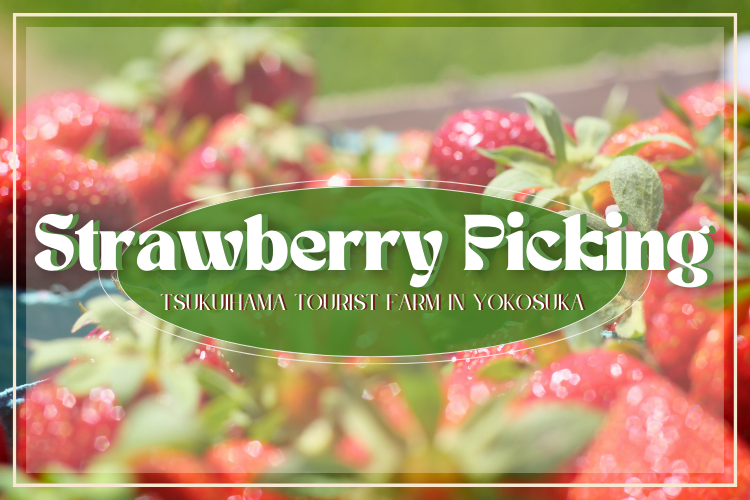Strawberry Picking | Tsukuihama Tourist Farm in Yokosuka

Enjoy Strawberry Picking Tsukuihama Tourist Farm in Yokosuka! In the Miura Peninsula, you can enjoy strawberry picking from early January, before the regular season begins. Treat yourself to a 30-minute all-you-can-eat experience with sweet, ripe red strawberries.
- About Tsukuihama Tourist Farm
- Why Miura’s Vegetables and Fruits Are Delicious
- Varieties of Strawberries Available at Tsukuihama Tourist Farm
- How to eat Strawberries: A Guide to Enjoying Every Bite
- Differences Between Japanese Strawberries and Strawberries from Abroad
- Event Information
- Strawberry Picking Association’s COVID-19 Prevention Measures
- Related Articles
About Tsukuihama Tourist Farm
Miura Peninsula is renowned for its rich agricultural produce, including oranges, strawberries, and sweet potatoes. Nestled in the gentle hilly terrain, Tsukuihama Tourist Farm offers delightful experiences such as mikan picking, spring strawberry picking, and sweet potato digging.
It’s a popular destination for kindergarten field trips, family outings, and local events. We welcome everyone to visit and enjoy the agricultural wonders.

Tsukuihama Tourist Farm is conveniently located at the foot of Mt. Takeyama (elevation 201m), famous for its azaleas and within walking distance from Keikyu Line Tsukuihama Station. Due to the mild climate of Miura Peninsula, you can enjoy strawberry picking in spring and orange picking in autumn earlier than in other regions.
The information center also features direct sales of vegetables, pickles, jams, and other products crafted by local farmers from Tsukuihama Tourist Farm.

Why Miura’s Vegetables and Fruits Are Delicious
Miura benefits from a relatively warm climate and abundant sunshine, complemented by the mineral-rich sea breeze blowing in from the ocean. This combination enhances the flavor of Miura’s agricultural produce. In this region, renowned for the Misaki fishing port famous for tuna, the remains from tuna processing, such as bones and offcuts, are even utilized as fertilizers for crops. Truly, it’s a synergy of the sun’s blessing, the soil’s richness, and the sea’s bounty!

Varieties of Strawberries Available at Tsukuihama Tourist Farm
Benihoppe (Red Cheeks) Strawberries

Origin of the Name Benihoppe
The name “Benihoppe” originates from the beautiful crimson color of the skin, the deep red hue extending to the center of the fruit, and the delightful taste as if the cheeks (hoppe) are falling.
Characteristics of Benihoppe
The fruit is moderately large, with a long conical shape, and the skin exhibits a glossy and vibrant red color. The flesh is tinged with a light red hue, and fully ripened fruits boast an excellent fragrance. With a strong sweetness and a slightly pronounced acidity, Benihoppe allows you to savor the inherent sweet and tart qualities of strawberries.
Selecting Benihoppe
Opt for strawberries with vivid red skin, ensuring thorough coloring up to the calyx area. Choose fruits with a delightful fragrance. Given Benihoppe’s slightly elongated shape, those closer to standard length are considered preferable.
Enjoying Benihoppe
Benihoppe offers a rich flavor profile with a balanced sweetness and acidity, making it delightful to eat as is. If the acidity is prominent, consider pairing it with condensed milk or incorporating it into strawberry milk. Given the vibrant red color of its flesh, Benihoppe is perfect for making strawberry jams that prominently display the fruit’s vivid hues. Additionally, using it in shortcakes or fruit sandwiches enhances the visual appeal of the strawberry cross-section.
Peak Season for Benihoppe
The season for Benihoppe spans from December to May, with March marking the peak of harvest. Cultivated primarily in Shizuoka Prefecture, its place of origin, Benihoppe is also grown in regions such as Ibaraki, Aichi, Kyushu, and beyond.
Yayoihime Strawberries

Origin of the Name Yayoihime
Typically, as temperatures rise beyond March, the quality of strawberries tends to decline. However, Yayoihime, as indicated by its name “Yayoi” meaning March, maintains high quality even in March, making it stand out.
Characteristics of Yayoihime
Yayoihime strawberries are larger in size, featuring a slightly orange-tinted bright red skin. They have a beautiful conical shape, with firm flesh that excels in transportability and shelf life. Moreover, they boast a strong sweetness, accompanied by a gentle acidity, making them a flavorful strawberry.
Choosing Yayoihime
Look for Yayoihime strawberries with bright red skin; they won’t necessarily turn a deep crimson even when ripe. As long as the entire berry is well-colored, it has sufficient sweetness. Choose those with a red hue around the calyx, and opt for ones with vibrant green calyxes. Avoid strawberries that have lost their shine or show signs of overripening.
How to Enjoy Yayoihime
Yayoihime strawberries are delicious as is, allowing you to savor the sweetness of the strawberry. Of course, they also enhance the flavor of cakes, parfaits, smoothies, and more. If making jam, considering Yayoihime’s mild acidity, adding a generous amount of lemon juice may enhance the taste.
Peak Season of Yayoihime
Yayoihime strawberries, primarily produced in Gunma Prefecture, start appearing in stores around January. The peak supply period is from February to March, with availability continuing until around May.
How to eat Strawberries: A Guide to Enjoying Every Bite
Indicators of Ripeness and Flavor
Select Strawberries with Red Stems
- Strawberries with red stems all the way to the top are fully ripe and uniformly colored.
- If there is white remaining on the strawberry, it indicates that it is not fully ripe.
- During strawberry picking, some may have white areas near the stems, so choose ones that are predominantly red with a glossy appearance.
Choose Berries with Red Seeds (Achenes)
- Berries with red seeds on the surface are a sign of full ripeness.
- Be cautious as some berries may have yellowish seeds. Verify this before picking during strawberry picking.
- Berries with raised flesh around the seeds are said to have a stronger sweetness.
Fresh Strawberries with Upturned Calyx (Green Leaves)
- Strawberries with upturned calyx are fresh and harvested at the optimal timing.
- This indication suggests that the strawberries are at their best in terms of flavor and juiciness.

Enhancing Flavor
Since the tip of the strawberry is the sweetest part, eating it from the stem side emphasizes the sweetness and makes it delicious.
Savoring Instant Sweetness
While it’s recommended to let strawberries reach room temperature for optimal sweetness, when picking them fresh in a greenhouse during strawberry picking, you can enjoy their maximum sweetness right away in the warm environment.
A Two-Step Delight
When enjoying strawberry picking, it’s common to eat them with condensed milk. However, I recommend trying them without anything at first to savor the natural sweetness and aroma of the strawberries. Since strawberries belong to the rose family, appreciating their fragrance is a key delight. As you progress, adding condensed milk to the experience can enhance and diversify the flavors, making it a recommended choice for the latter part of your strawberry feast.

Differences Between Japanese Strawberries and Strawberries from Abroad
In European countries, strawberries have been consumed since the Stone Age, but these were not cultivated varieties; they were wild. Wild strawberries in Europe had a mild sweetness and strong acidity, with various parts of the plant, including stems, leaves, and roots, primarily utilized for medicinal purposes. When these strawberries made their way to Japan, they underwent numerous breeding improvements, transforming into a preferred delicacy known for its strong sweetness.
In Japan, there is a high demand for strawberries, and every strawberry sold must meet strict standards for juiciness, sweetness, size, and other characteristics. To achieve this high quality, producers in Japan continually develop new strawberry varieties and unique cultivation methods. Strict quality control methods are also employed.
These differences are general trends, and individual strawberries may exhibit various characteristics. To appreciate the differences based on regions and varieties, it is recommended to try different strawberries.

Introduction to Japan (Late Edo Period)
Strawberries from the Netherlands (“Oranda Ichigo”) were first introduced to Japan in Nagasaki. Limited popularity during the Edo period; widespread cultivation began in the Meiji era. The “Fukuba” variety, initially reserved for the imperial family, laid the foundation for Japanese strawberries.
Strawberries became widely available during the Showa era. The American variety “Duner” introduced after the war played a crucial role in spreading cultivation nationwide. Subsequent breeding efforts led to the proliferation of strawberry production across Japan.
Ongoing advancements in strawberry breeding have resulted in approximately 200 different strawberry varieties. Today, strawberries are a diverse and widely enjoyed fruit in Japan and around the world.

Event Information
Note: On weekends, there may be crowds, and entry may be restricted. Please check the strawberry calendar or inquire at the local information center before heading out.
Location
Tsukuihama Tourist Farm (Tsukuihama Kanko Nouen)
Address
5 Chome-15-20 Tsukui, Yokosuka, Kanagawa 239-0843
Access
- By train: Get off at Keikyu Tsukuihama Station and walk 20 minutes.
- Shuttle bus service is available.
- By car: Take the Yokohama-Yokosuka Road, exit at Saura IC, turn right, then turn left at the Shimada Park signal, right at the entrance of Keikyu Nobi Station, and right at the 134th intersection of Nagasawa Station.
Business Hours
From January 1, 2023, to May 5, 2023
Every day from 9:00 AM to 3:00 PM
(Availability limited to the strawberries on the day; ending as soon as they run out)
Admission Fee
- January 1 to January 7: ¥2,200
- January 8 to end of February: ¥2,000
- March 1 to April 5: ¥1,800
- April 6 to May 5: ¥1,500
Please purchase the “Admission Ticket” at the on-site information center. The fee is for a 30-minute session (for ages 3 and above).
Closed Days
Varies depending on the season.
Parking
Capacity: 60 cars (No Charge)
Contact
- Tsukuihama Tourist Farm Office (Weekdays 9:00 AM – 3:00 PM) Tel: 046-849-4506
- On-site Information Center (During the event period, 9:00 AM – 3:00 PM) Tel: 046-849-5001
Official Website
JA Yokosuka Hayama Tsukuihama Tourist Farm
Official English Brochure
Tsukuihama Tourist Farm Brochure
Strawberry Picking Association’s COVID-19 Prevention Measures
At our strawberry picking facility, we have implemented the following measures to prevent the spread of COVID-19
- Staff undergo regular temperature checks, wear masks, and practice handwashing (hand sanitization).
- Reception areas will have spaced lines to maintain social distancing.
- Hand sanitizing alcohol will be available at each entrance.
- Regular ventilation of the sales area and greenhouse structures.
Request to Our Customers
- In the interest of preventing COVID-19 transmission, there may be restrictions on the number of visitors.
- We kindly ask all visitors to wear masks or face shields upon entering. Additionally, please use the provided hand sanitizing alcohol upon entering the greenhouse.
- Maintain a one-way flow inside the greenhouse.
- Minimize conversations while inside the greenhouse.
- Please consume any fruit you have touched.
- Dispose of strawberry stems and fruit peels in the designated areas.






